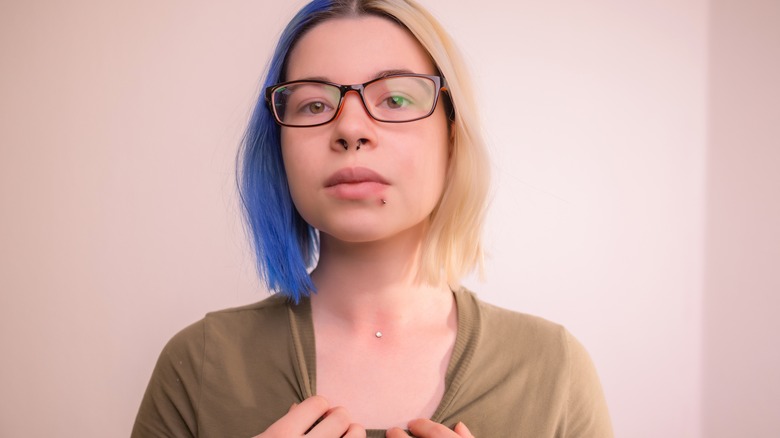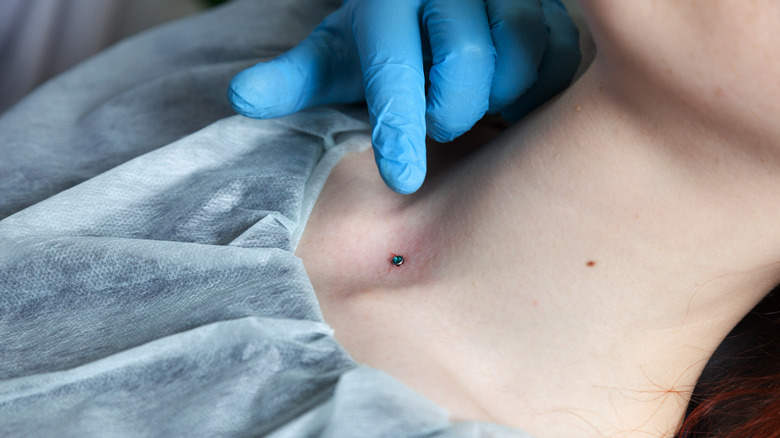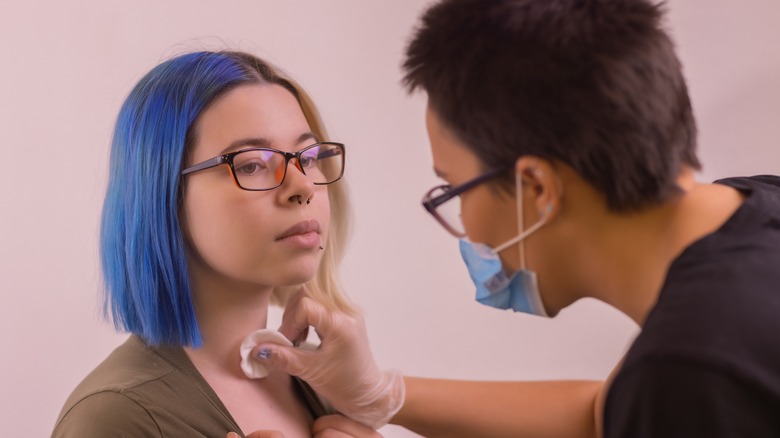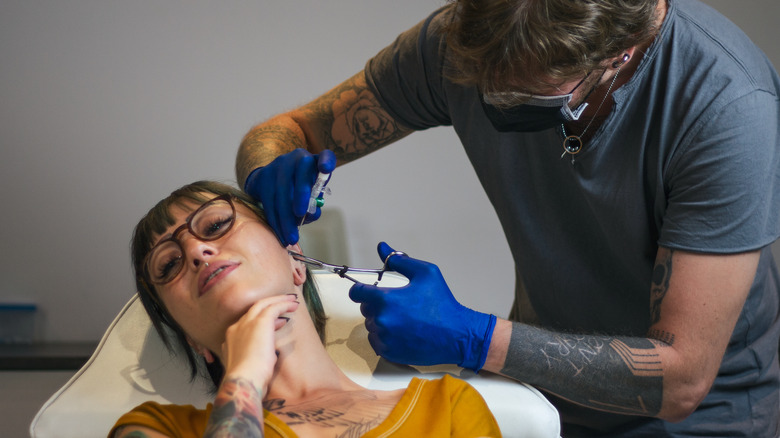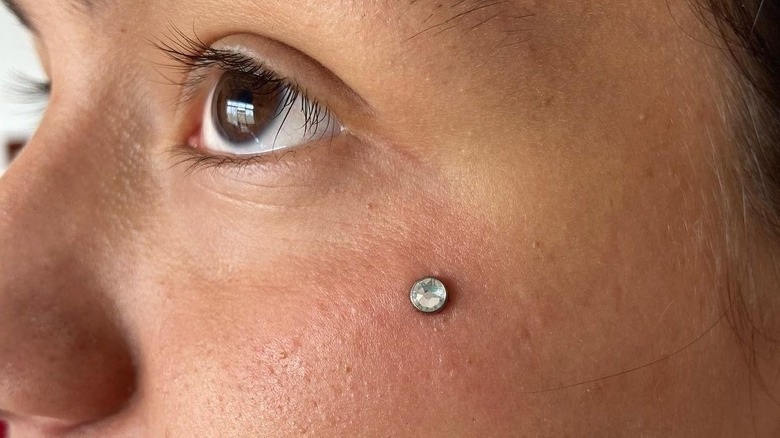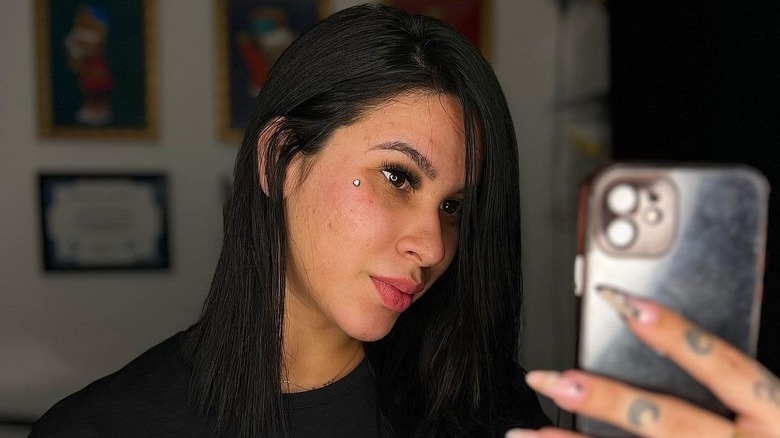The Ultimate Guide To Dermal Piercings
Gone are the days when getting one piercing in each earlobe was the norm. These days, multiple ear piercings are cool, and playing around with some piercings on other parts of the body is becoming increasingly popular — the more, the merrier, basically.
One type of piercing that's starting to gain traction is the dermal piercing. This is largely thanks to various celebs sporting the look. This trendy piercing took over TikTok with #dermalpiercing sporting millions of views, and people are taking to it like ducks to water. Cardi B even went as far as to post the entire process of getting the piercing on her Instagram account. For those confused about what a dermal piercing is, it's a semi-permanent piercing that appears like it's magically floating on the wearer's skin. People often get these piercings on their chests (as Cardi B did), their necks, cheeks, and even their fingers.
Professional body piercer Lynn Loheide tells Elite Daily that they've seen an increase in customers who are eager to get dermal piercings. "I do a few a month," they tell the outlet, adding that this piercing can be much trickier than others. "They are, however, very anatomy dependent, meaning if someone doesn't have the appropriate anatomy for them, we can't safely do them in that location," Loheide explains. If you're eager to try this trend for yourself, read on for everything you need to know before you commit to a dermal piercing.
What is a dermal piercing?
When you get a dermal piercing and hear your piercer refer to it as a single-point or microdermal piercing, you can rest assured that it's the exact same thing. The names may sound a little intimidating, but this piercing isn't as scary as you might think.
Dermal piercings are designed to appear like it's part of the skin. This look is achieved by creating a piercing that has no exit point. Yup, a dermal piercing is one-sided, so to speak. "It's actually a single point piercing that is anchored to hold tight to the surface of the skin with a beautiful gemstone or flat piece of jewelry on top," professional body piercer Jessie Darling tells Byrdie. The anchor Darling refers to is the jewelry's base (which is around 6-7 millimeters long), which is strategically placed just beneath the skin.
This can seem, erm, a little invasive, but when professional body piercer Lynn Loheide explains it, dermal piercings sound a lot less scary. "They are pierced using a piercing needle to create a small pocket in the skin, and the base is inserted into this pocket," they tell Elite Daily. "The base is about the size of a grain of rice, and the piercing process itself is often very easy."
Dermal piercings are semi-permanent, lasting anything from 3-7 years. So keep in mind that it won't last forever and that you'll more than likely need to have it redone at some point.
Dermal piercings vs. surface piercings
You might have heard people use the terms dermal and surface piercings interchangeably, but it's incredibly important to understand that these two piercings are not the same. They might both be geared toward piercing the surface of the skin, but while dermal piercings can be described as one-way piercings with no exit, surface piercings function pretty much the same as traditional piercings — they have an entry and exit point. Because of this, your body is much more likely to reject the piercing. This often leaves some unwanted scars, especially if the piercing is placed in an area where there is a lot of natural movement. The jewelry that's typically used often resembles that used for belly button piercings: A C-shaped bar with a post on each end.
Because surface piercings have a bad reputation when it comes to longevity, dermal piercings have started to take over, with surface piercings becoming less popular. Because the dermal piercing doesn't have an exit point, the body can't reject it as easily. Dermal piercings heal faster and more easily than surface piercings, and the risk of infection is also lower. Thanks to the skin healing around the jewelry, rejection isn't as likely to occur as with surface piercings.
Where on your body can you have a dermal piercing?
What makes dermal piercings so fun and versatile is that they can be placed on any flat surface of the body. There is a catch, however. We all have unique bodies, which means that for some, certain areas won't be as suitable for dermal piercings as for others. For one, the desired spot needs to have thick skin — if it doesn't, the dermal's anchor won't be able to, well, anchor itself, and you'll likely end up with a rejected piercing, and no one wants that.
Some of the most popular spots on the body for dermal piercings are the thighs (definitely no lack of thick skin there for most of us), the lower back, stomach, nape of the neck, chest, and cheekbones.
It's important to discuss the desired placement of your dermal piercing with your piercer beforehand. They'll be able to tell you if the spot you want to be pierced will work with your anatomy.
What to do before you get a dermal piercing
Before you get a dermal piercing, it's important to familiarize yourself with the type of jewelry that's typically used. Not only can this help you figure out if it fits your personal style, but your choice of jewelry will also determine what type of piercing method the piercer ends up using. Three types of jewelry are typically used with dermal piercings: a diver, an anchor, and a top.
If you opt for a diver, you won't be able to change the top of the jewelry. Divers have a pointy base with a pre-attached top and are inserted using a dermal puncher instead of a needle. If you don't opt for a diver, your piercer will insert an anchor and a dermal top. The anchor is a piece of jewelry that's inserted into the skin to keep the piercing in place. There are two types of anchors: One has two little "feet" that extend from both sides (also known as a footed dermal anchor) while the other type has a simple, round base. Some of these anchors have some extra holes in their base, which allows for skin to grow through as the piercing heals. This leads to a more secure piercing that's less likely to reject early or fall out.
Once the anchor is in place, your piercer will attach the dermal top. Tops range from simple designs like balls, disks, and cones, to fun shapes like dragonflies, stars, and hearts.
What is the process of getting a dermal piercing like?
A dermal piercing might be semi-permanent, but it actually takes only a few minutes to get it done. If you're squeamish, you can rest assured that the whole process will be over before you know it. In fact, the disinfecting process will probably take longer than the actual piercing process, especially if you go to an experienced artist.
Speaking to Byrdie, professional body piercer Jessie Darling explains that after the area is thoroughly disinfected to prevent infection, the piercing artist will draw a dot on the spot where the piercing will go with a marker. Next, they'll let you have a look to ensure you're happy with the placement. "We then use a tool called a dermal punch to remove a little (1.5 to 2 millimeter) pocket of skin. We then use a taper tool that allows us to create room for the anchor base to fit snugly," Darling explains.
Depending on the type of jewelry you choose, the piercer will use either a dermal punch, as Darling explains, or a needle to create the pocket in the skin where the anchor is placed. Your piercer might fiddle with the anchor a bit to ensure it fits well. Then they'll proceed to attach the dermal top to the jewelry (if you're not getting a diver, which already has a top attached). And that's it!
How much does a dermal piercing cost?
First things first: If the piercer you're considering is significantly cheaper than other piercers in your area, you should be very skeptical. Professional body piercer Lynn Loheide tells Elite Daily that the price for a dermal piercing depends on the jewelry used. Those with lower rates often also use sub-par quality jewelry, which won't do you any good in the long run.
Loheide points out that you can expect to pay anything between $80-$120 (this covers the piercing and the jewelry). Sure, that's pretty pricey, but Loheide explains that manufacturing the anchors correctly requires quite the process. "More importantly is the material — since dermals can't be taken in and out for things like surgery or medical imaging, it's essential to be pierced with implant-grade materials that are safe for these procedures," they say, adding that getting cheap, low-quality jewelry will mean that you need to take out your piercing when you go for any medical procedures, which will mean bidding your dermal piercing goodbye. Loheide says that implant-grade titanium is often best because it's safe for most medical procedures.
Does it hurt to get a dermal piercing?
If you've ever gotten any type of piercing, you probably know that they aren't exactly painless. You are making a tiny hole in your skin, so you will feel something. But dermal piercings are a lot like tattoos — how much they hurt depends on where you get them and how high your pain threshold is. With that said, it appears that most experts are confident that dermal piercings don't fall into the category of piercings that hurt like hell. What's more is that you can always take some pain meds like Tylenol before your appointment, especially if you know you're the sort who tends to experience pain more intensely than others.
According to professional piercer Tom Gottschalk, experienced piercers are often great at making the process as painless as possible. "If you're going to a reputable piercer who knows what they're doing, it should be pretty easy," Gottschalk tells PopSugar, adding that dermal piercings, in particular, tend to only cause minor discomfort. "It lies on the easier side of the spectrum when done properly," Gottschalk adds. You may, however, experience more or less pain depending on where you get your dermal piercing, but as long as you go to someone who knows what they're doing, you should be just fine.
What is the aftercare for a dermal piercing?
Once you get your dermal piercing, you'll have to follow a strict aftercare routine to ensure it heals up properly and lasts as long as possible. According to professional piercer Tom Gottschalk, aftercare is pretty simple: "Keep it clean, and leave it alone," he tells PopSugar. "With surface anchors, you really want to make sure you're not touching it on stuff, because the odds of it being ripped out of your body are much higher than your average piercing," Gottschalk adds.
You can clean your dermal piercing with a saline solution twice a day and keep it bandaged to keep it clean, especially if you play sports. Just make sure the bandage isn't wrapped around it too tight and refrain from wearing tight clothes — this will only irritate the area more. It's also important to note that you shouldn't use any harsh chemicals to clean the piercing — rubbing alcohol is out, and so is neosporin and hydrogen peroxide. While these compounds might be great for killing bacteria, they are harsh on the skin and can really mess with the healing process, so steer clear. Gottschalk warns that failing to follow an adequate aftercare regimen can lead to your body rejecting the piercing way ahead of time, so make sure you stick to it.
How long is the healing process for a dermal piercing?
You'll be happy to learn that dermal piercings pretty much heal within the same timeframe as other piercings. You can expect it to be all healed up within 1-3 months. If you follow a good aftercare regimen, you should have little to no discomfort while it heals. Dealing with some mild crusting and swelling is perfectly normal, especially shortly after you get the piercing. However, if you start to notice a foul odor, skin that looks very red (or appears like it's forming a rash) or experience swelling and pain that keeps you up at night, you should speak with your piercer or doctor. While crustiness is normal, you should also keep an eye out for any discharge that has an odd color.
While the piercing is healing, make sure you leave it alone. As much as you might want to change the jewelry, wait until it's completely healed. Changing the top before the piercing is fully healed can really set you back. Don't fiddle with it — this means no touching, turning, or fidgeting with the jewelry. This can disturb the skin that grows around and through the anchor, leading to a greater risk of rejection and scarring.
It's possible your body may reject a dermal piercing
When getting a dermal piercing, rejection isn't just a possibility — it's a certainty. Yup, no matter how well you look after your piercing, your body will eventually reject the anchor and push it back out to the surface. "They're not permanent piercings by any means," professional piercer Tom Gottschalk tells PopSugar. "It's so different for everybody. It could [happen in] a month or three months — it could be 10 years! But eventually, it's coming out," Gottschalk says. This is the reason why Gottschalk recommends that people don't fiddle with the piercing and follow a solid aftercare regimen.
Speaking to Elite Daily, professional body piercer Lynn Loheide explains that it's hard to say how long a dermal piercing will last for each individual. Because our bodies are so unique, we all have different experiences. Loheide adds that having a dermal piercing last for three years is already a great feat, especially since some people's bodies reject it within a couple of months.
So, is there a possibility to save the piercing once it starts to reject? Sometimes, yes. Your piercer will be able to tell best, but Gottschalk says his goal is often to ensure no excessive scarring takes place during the rejection process, which means removing the jewelry as soon as signs of rejection start to show. This usually manifests as irritation, and you'll likely see that the jewelry appears to have moved from its original spot and appears droopy.
Risks associated with dermal piercings
No piercing comes without risks, and dermal piercings are no different. They are, however, more likely to cause complications than some other piercings. As with any other piercing, dermal piercings can become infected — this can be prevented by going to a reputable piercer and by following the aftercare instructions carefully. Another undesirable complication is scarring. Because dermal piercings reject at some point, some scarring is inevitable. Tissue damage is also a possibility, especially if the piercer places the anchor too deep beneath the skin. This can have a negative effect on the nerves and blood vessels in the area. This is why it's important to go to a reputable professional.
Another pesky risk that comes with dermal piercings is hypergranulation. This condition is characterized by a red bump that usually forms when the piercing is mistreated — fidgeting with the jewelry, covering the piercing with tight clothing or makeup, or failing to clean it regularly can all lead to hypergranulation. Jewelry that's way too tight for the piercing can also cause this condition. You may also deal with jewelry displacement. This usually happens when the piercer failed to insert the anchor deep enough.
If you experience any of the abovementioned complications or deal with excessive pain or swelling around the pierced area, make an appointment with your doctor or piercer. A nasty odor, hot skin, or a discharge that looks green or yellow could be a sign of infection or early rejection.
What jewelry can you use for your dermal piercing?
The jewelry you end up choosing for your dermal piercing is pretty important because as we previously mentioned, you'd want to be able to keep it in even if you have to go for certain medical procedures. So, how do you choose? Well, it all depends on your skin type and personal preference.
The most popular choice is surgical-grade stainless steel — this is a great choice for many because it's hypoallergenic. Niobium is also a good choice for the same reason and it'll be a little cheaper than titanium jewelry. It also has a mystical gray-white color, so if you want something a little different, this metal is perfect. Titanium is the queen of metals, especially when it comes to dermal piercings. Why? Because surgical-grade titanium is known for being very kind to sensitive skin. If you're worried about allergies or irritation, this is one of the best metals to go with. Gold (and rose gold) can also be a good choice, given you opt for 14-karat gold. It's pretty tough and doesn't require a lot of extra care to keep it looking good. Quality gold jewelry is also free of nickel, which means you're less likely to experience irritation or allergies.
How do you change your dermal piercing jewelry?
Few things are more exciting than finally changing the jewelry on a new piercing, and once your dermal piercing is all healed up (usually within three months), you can do just that. Changing the jewelry might feel a little daunting, so make sure you're not in a hurry when you attempt it for the first time.
Start by washing your hands (and your piercing) thoroughly, preferably with a saline solution and antibacterial soap (yes, you should play it very safe), and then proceed to turn the dermal top in a counterclockwise direction. Now, your piercer likely made sure they secured the top properly, which might make it a little hard to get loose. If you can't seem to loosen it, don't force it — you'll only irritate the piercing. If you do manage to loosen it without too much of a fuss, you can screw on the new top in a clockwise direction. Make sure it's secure so you don't lose it. Once you're done, use some saline solution to clean the area again.
If you end up not being able to loosen the top yourself, pay a visit to your piercer. They'll likely be more than happy to change it for you and give you some tips on how to do it yourself next time.
What should you do if you don't want a dermal piercing anymore?
If your dermal piercing is no longer appealing to you, you do have the option to remove it. However, never try to remove the piercing yourself. This is a bad idea for a myriad of reasons (including causing permanent damage to your skin). Make an appointment with your piercer to get the piercing removed — this will lower your risk of complications and help prevent excessive scarring.
The removal process is pretty simple. Your piercer will sterilize the area, unscrew the jewelry, then proceed to gently massage the skin to help loosen the anchor. After this, they'll use a scalpel to make a very small incision around the anchor. They'll then extract it from the skin and stitch up the wound if necessary. Most piercers will apply a bandage to keep the area clean and protected. This process can be a little painful, but over-the-counter pain meds should be able to take care of it. If the wound continues to hurt excessively or appears slow to heal, make an appointment with your doctor.

